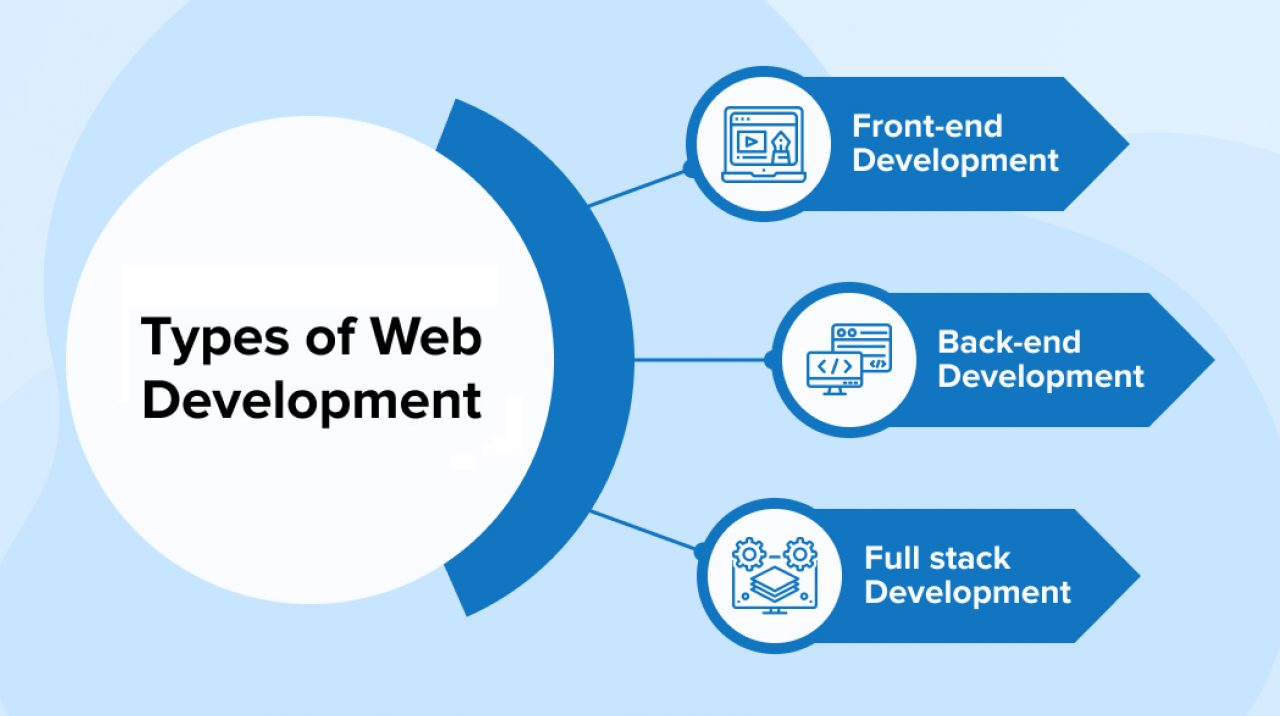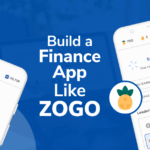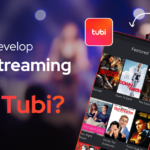In this concise and informative piece, we will explore the diverse landscape of web development, offering insights to help you make informed decisions for your upcoming project.
Web development has evolved tremendously, leading to various approaches such as Front-end, Back-end, and Full-stack development. We will delve into each types of web development with its unique characteristics, tools, and technologies, helping you grasp their functionalities and applications.
Whether you’re seeking to expand your skillset or a business owner aiming to hire web developers, this blog aims to equip you with the knowledge necessary to navigate the world of web development confidently.
In this blog we have complied types of web development, empowering you to create dynamic and engaging online experiences. Let’s embark on this enriching journey together!
Table of Contents
Types of Web Development

Web development is a dynamic field that encompasses a wide range of technologies, tools, and frameworks to create, maintain, and enhance websites and web applications.
As businesses and organizations continue to rely on the Internet for their operations, understanding the various types of web development is crucial for ensuring a successful project. In this blog, we will explore the key types of web development and their respective strengths and use cases.
1. Front-end Web Development:
The client side of a website or online application is the main emphasis of front-end web development. Making the site aesthetically beautiful and interactive requires planning and implementing the user interface and experience. HTML (Hypertext Markup Language), CSS (Cascading Style Sheets), and JavaScript are important front-end technologies.
The layout is styled using CSS, HTML organizes the content, and JavaScript adds the functionality. renowned front-end frameworks like Angular, React, and Vue.Js make the development process more straightforward, making it simpler to design intricate user interfaces. It is one of the best types of web development.
Which Languages Are Utilize In Front-End Development?
| Language | Technology | Explanation |
| HTML | Markup | The structure and content of a web page are created using HyperText Markup Language (HTML). It defines the layout and elements. |
| CSS | Styling | Cascading Style Sheets is responsible for the visual presentation of web pages, including layout, colors, and fonts. |
| JavaScript | Scripting | A flexible programming language that makes web pages more interactive by adding interaction and dynamic behavior.
|
| TypeScript | Scripting | A superset of JavaScript, adding static typing and additional features to enhance code quality and maintainability. |
| Sass (SCSS) | Styling | A CSS preprocessor that extends CSS with variables, nested rules, and other features to simplify and organize styles. |
| Less | Styling | Another CSS preprocessor that provides additional features and simplifies CSS development with its own syntax. |
| JSX | Markup | A syntax extension for JavaScript, often used with React, to write component-based UIs in a more declarative manner. |
| Vue.js | Framework | A progressive JavaScript framework for building user interfaces and single-page applications with a component-based approach. |
| Angular | Framework | A comprehensive platform for building web applications using TypeScript, with powerful features and tools for types of web developers. |
| React | Library | A JavaScript library for building user interfaces, focusing on the component-based approach and efficient rendering. |
2. Back-end Web Development:
Backend web development is one of the best types of web development. The server side of online applications is the subject of back-end web development.
It includes controlling databases, responding to server requests, and putting application logic into place. The server-side components are created by the back-end and different types of web developers using languages like Python, Ruby, PHP, Node.js, or Java.
Additionally, they store and retrieve data using databases like MySQL, PostgreSQL, or MongoDB. A web application’s effectiveness and security depend on a well-designed back end.
Which Are the Languages Used In The Back-End Development?
| Technology | Language | Explanation |
| Node.js | JavaScript | A server-side JavaScript runtime called Node.js enables programmers to create scalable network applications. It employs a non-blocking, event-driven I/O architecture. |
| Python Django | Python | A high-level Python web framework called Django provides quick development and straightforward, practical design. |
| Ruby on Rails | Ruby | A Ruby web development framework called Ruby on Rails places an emphasis on convention over configuration.
|
| ASP.NET | C# | ASP.NET is a web framework developed by Microsoft that uses C# as its primary language for back-end development. |
| PHP | PHP | PHP is a widely-used server-side scripting language designed for web development to create dynamic web pages. |
| Java Spring | Java | Spring is a Java-based framework providing a comprehensive infrastructure for developing Java applications. |
| Express.js | JavaScript | Express.js is a minimalistic Node.js framework for building web applications with a simple, flexible API. |
| Ruby Sinatra | Ruby | Sinatra is a lightweight web application library for Ruby that enables rapid development with minimal overhead. |
| Flask | Python | A simple-to-use micro web framework for Python, Flask is ideal for creating tiny to medium-sized web applications. |
3. Full-stack Web Development:
Front-end and back-end technologies are both strong suits for full-stack web developers. They are equipped to manage server-side processes and create user interfaces, among other areas of types of web development.
Full-stack development companies have a wide range of skills and can collaborate with different types of web development or work solo on full projects.
What Tech Stacks Are Employed In Full-Stack Web Development?
| Tech Stack | Language | Explanation |
| MERN Stack | MongoDB | NoSQL database that stores data in JSON-like documents. |
| Express.js | Node.js framework for building web applications. | |
| React.js | JavaScript library for building user interfaces. | |
| Node.js | JavaScript runtime for server-side applications. | |
| MEAN Stack | NoSQL database for storing data in JSON-like documents. | |
| Express.js | Node.js framework for building web applications. | |
| Angular | TypeScript-based framework for building UI applications. | |
| Node.js | JavaScript runtime for server-side applications. | |
| LAMP Stack | Linux | Open-source operating system. |
| Apache | Web server software for serving web content. | |
| MySQL | Relational database management system. | |
| PHP | Server-side scripting language for web development. | |
| MEVN Stack | MongoDB | NoSQL database for storing data in JSON-like documents. |
| Express.js | Node.js framework for building web applications. | |
| Vue.js | Progressive JavaScript framework for building UIs. | |
| Node.js | JavaScript runtime for server-side applications. | |
| Ruby on Rails Stack | Ruby | Dynamic, object-oriented programming language. |
| Ruby on Rails | The web application framework is written in Ruby. | |
| Emphasizes convention over configuration. | ||
| Django Stack | Python | High-level programming language is known for readability. |
| Python Django | High-level Python web framework for rapid development.
and clean, pragmatic design. |
4. Responsive Web Development:
Responsive web creation is one of the best types of web development which is crucial in today’s mobile-first environment. In order to provide a seamless user experience, responsive websites optimize and adjust their layout and design for use on a variety of devices and screen sizes.
In order to accomplish responsiveness and provide a user-friendly experience across desktops, laptops, tablets, and smartphones, front-end developers use CSS media queries and adaptable grid systems.
Responsive Web Development Techniques: Which Tech Stacks Are Used?
| Technology | Language | Explanation |
| HTML | Markup language | Defines the structure and content of the web page. |
| CSS | Styling language | Styles the HTML elements to control the layout and appearance of the page. |
| JavaScript | Programming language | Enables interactivity and dynamic content on the web page. |
| Bootstrap | CSS framework | Provides pre-designed components and responsive layout utilities. |
| jQuery | JavaScript library | Simplifies DOM manipulation and event handling. |
| Sass/SCSS | CSS preprocessor | Extends CSS with features like variables and nested rules for better code organization. |
| React | JavaScript library | A component-based library for building interactive user interfaces. |
| Angular | JavaScript framework | A powerful type of framework in web development for building complex, single-page applications. |
| Vue.js | JavaScript framework | A progressive framework for building user interfaces with easy integration. |
| Node.js | JavaScript runtime | Allows server-side JavaScript execution for building scalable applications. |
| Express.js | JavaScript framework | A minimal and flexible Node.js framework for building web applications and APIs. |
5. Single-Page Applications (SPA):
Web applications known as SPAs load just one HTML page and dynamically change the content in response to user input.
This strategy reduces the necessity for page reloads by giving users a more fluid user experience. Front-end frameworks like React, Angular, or Vue.js are used to build SPAs, together with APIs to fetch data without refreshing the page. It is critical to consider this as one of the best types of web development.
Are There Any Tech Stacks That Are Used In Single-Page Applications (SPA)?
| Technology | Language | Explanation |
| React | JavaScript | A component-based JavaScript library for building interactive user interfaces with virtual DOM updates. |
| Angular | TypeScript | A comprehensive JavaScript framework for building complex SPAs with two-way data binding and dependency injection. |
| Vue.js | JavaScript | A progressive framework for building user interfaces with a focus on simplicity and ease of integration. |
| Ember.js | JavaScript | A framework for creating ambitious web applications with strong conventions and a powerful router. |
| Backbone.js | JavaScript | A lightweight framework for organizing code in an MVC (Model-View-Controller) structure. |
| Meteor | JavaScript | A full-stack framework for building real-time SPAs with an isomorphic codebase. |
| Aurelia | JavaScript | A next-generation framework designed for simplicity and extensibility. |
| Redux | JavaScript | A predictable state management library used in combination with React or other view libraries. |
| GraphQL | Query language | A query language for APIs that enables clients to request only the data they need. |
| Node.js | JavaScript | A JavaScript runtime that allows server-side execution for building scalable SPAs. |
| Express.js | JavaScript | A minimal and flexible Node.js framework for building web applications and APIs. |
6. Progressive Web Apps (PWA):
PWAs give users a web browser experience comparable to native mobile apps by fusing the best elements of online and mobile applications. Even on subpar networks, they are dependable, quick, and interesting.
On users’ smartphones, PWAs can be deployed, enabling offline access and push alerts. To accomplish these functionalities, they make use of contemporary web technologies like Service Workers which made it one of the best types of web development.
Are There Any Technical Stacks Used To Develop Progressive Web Apps (PWA)?
| Technology | Language | Explanation |
| HTML | Markup language | Defines the structure and content of the web app. |
| CSS | Styling language | Styles the HTML elements to control the appearance of the web app. |
| JavaScript | Programming language | Enables interactivity and dynamic functionality in the PWA. |
| Service Workers | JavaScript | Background scripts that enable offline caching and push notifications, enhancing PWA capabilities. |
| Web App Manifest | JSON | A JSON file that provides metadata about the PWA, such as name, icons, and theme colors. |
| Responsive Design | – | Ensures the PWA adapts to different screen sizes and devices. |
| HTTPS | – | A secure protocol that ensures data integrity and enables PWA features like Service Workers. |
| IndexedDB | Database | A client-side database for storing data locally in the PWA. |
| Workbox | JavaScript library | A set of tools for simplifying Service Worker implementation and caching strategies. |
| PWACompat | JavaScript library | A library that adds PWA features to non-compliant browsers for better cross-browser support. |
| Firebase | – | A backend-as-a-service platform that provides various features like hosting, authentication, and database for PWAs. |
7. Content Management Systems (CMS):
CMS platforms enable website owners to create, manage, and modify content without in-depth technical knowledge. Popular CMS options include WordPress, Joomla, and Drupal. CMS-based web development is one of the best types of web development suitable for blogs, news web portal development, and websites requiring frequent content updates.
Which Technology Stacks Are Used in Content Management Systems (CMS)?
| Technology | Language | Explanation |
| WordPress | PHP | A popular CMS with a vast ecosystem of plugins and themes for website customization. |
| Joomla | PHP | An open-source CMS known for its flexibility and extensibility. |
| Drupal | PHP | A powerful CMS used for building complex and high-traffic websites. |
| Magento | PHP | An e-commerce platform tailored for online stores with extensive customization options. |
| Shopify | Ruby | A cloud-based e-commerce platform that simplifies setting up online stores. |
| Contentful | JavaScript | A headless CMS that enables content management via an API for various platforms. |
| Strapi | JavaScript | An open-source headless CMS that offers flexibility and customization options. |
| Ghost | JavaScript | A CMS focused on blogging and publishing content with a user-friendly interface. |
| Umbraco | C# | A flexible CMS built on the Microsoft .NET framework. |
| Wix | JavaScript | A website builder platform with an integrated CMS for easy website creation. |
| Squarespace | JavaScript | A website builder platform with built-in hosting and CMS for easy website development. |
8. E-commerce Development:
Building online shops and marketplaces allows businesses to offer goods and services online. This process is known as “e-commerce web development,” which is one of the best types of web development.
The required tools are available through e-commerce systems like Shopify, WooCommerce, and Magento for setting up and operating online stores. In this web development type area, security, payment integration, and a positive user experience are essential factors.
E-commerce Development Tech Stacks: What Are They?
| Technology | Language | Explanation |
| Magento | PHP | A powerful and feature-rich e-commerce platform for building large-scale online stores. |
| Shopify | Ruby | A cloud-based e-commerce platform that simplifies setting up and managing online stores. |
| WooCommerce | PHP | A popular WordPress plugin that adds e-commerce functionality to WordPress websites. |
| BigCommerce | PHP/JavaScript | An e-commerce platform that provides a wide range of built-in features for online stores. |
| PrestaShop | PHP | An open-source e-commerce platform with a user-friendly interface and extensive add-ons. |
| OpenCart | PHP | A lightweight and easy-to-use open-source e-commerce solution. |
| React | JavaScript | A JavaScript library for building interactive user interfaces in e-commerce applications. |
| Angular | TypeScript | A powerful JavaScript framework for developing complex e-commerce web applications. |
| Node.js | JavaScript | A JavaScript runtime for building scalable and real-time e-commerce backends. |
| Express.js | JavaScript | A flexible Node.js framework for building e-commerce APIs and web applications. |
| MongoDB | NoSQL | A NoSQL database used for handling large volumes of data in e-commerce applications. |
9. Web Security and DevOps:
Web development isn’t just about writing code; it also includes ensuring the security and performance of web applications. Web security specialists focus on identifying and mitigating vulnerabilities, protecting user data, and preventing attacks like Cross-Site Scripting (XSS) and SQL injection.
DevOps practices, on the other hand, focus on streamlining the development, testing, and deployment processes, fostering collaboration between custom web development companies and operations teams. It is an incredibly designed type of web development.
DevOps and Web Security Stacks: What Are They?
| Technology | Explanation |
| DevOps Tools | Various tools like Jenkins, GitLab CI/CD, and Travis CI are used for automating software development processes and continuous integration/continuous deployment. |
| Docker | A platform for packaging and deploying applications and dependencies into containers at multiple locations. |
| Kubernetes | A platform for orchestrating containerized applications by automating deployment, scaling, and management. |
| Ansible | A configuration management solution that automates infrastructure provisioning, setup, and application deployment. |
| Terraform | A tool for managing infrastructure resources across several cloud providers that uses infrastructure as code (IaC).
|
| OWASP Top 10 | The top ten online application security threats as determined by the Open Online Application Security Project. |
| Security Scanners | For security testing, vulnerability scanning, and penetration testing, there are tools like OWASP ZAP and Burp Suite. |
| SSL/TLS | Protocols ensure secure communication between clients and servers when data is being transferred over the Internet. |
| WAF (Web Application Firewall) | A security appliance or service that filters and monitors HTTP/HTTPS traffic between a web application and the internet. |
| IDS/IPS | Intrusion Detection Systems (IDS) and Intrusion Prevention Systems (IPS) help identify and prevent security threats and attacks. |
| Security Headers | HTTP response headers like Content Security Policy (CSP) and X-XSS-Protection enhance web application security. |
In A Nutshell!
In conclusion, understanding the different types of web development is crucial for your next project’s success. Whether front-end, back-end, or full-stack development, each plays a vital role in creating a functional and user-friendly website.
Consider your project’s requirements and goals to choose the right approach, ensuring a seamless online experience for your audience. So if you are one of the people interested in web development then we hope you must have chosen one of the preferable choices from our guide of types of web development. Happy developing!
Frequently Asked Question
1. What Are The Primary Types Of Web Development?
Let’s look at these primary types of web development given below.
- Front-end Development: Utilizes JavaScript, CSS, and HTML to create user interfaces.
- Back-end Development: Manages database operations and server-side operations.
- Full-stack Development: Combines experience in the front-end and back-end.
2. How Does Front-End Development Impact User Experience?
Front-end development shapes the user interface and experience, ensuring responsive design, smooth interactions, and intuitive navigation, leading to higher user engagement and satisfaction.
3. What Are The Benefits Of Back-End Development For Businesses?
Back-end development ensures data security, efficient processing, and scalability, enabling businesses to manage large volumes of data and handle complex operations seamlessly.
4. How Does Full-Stack Development Benefit Startups?
Full-stack web development companies offer versatility, reducing the need for multiple specialists, thereby saving costs and accelerating the development process for startups with limited resources.
5. Which Type Of Web Development Is Ideal For My Project?
Choosing the right types of web development depends on the project’s complexity and goals. Front-end suits static websites, while dynamic platforms often require full-stack developers and the back-end is vital for handling extensive data and operations. Consult our experts to decide!

























